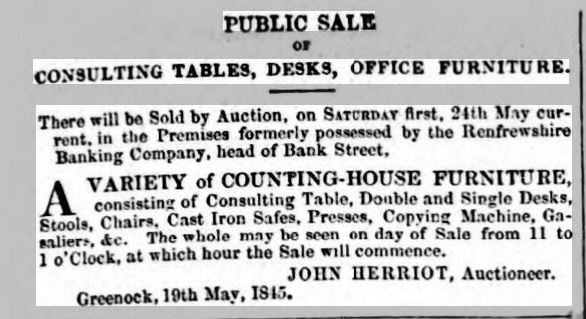On 1 April 1842 the Renfrewshire Bank in Greenock stopped all payment causing widespread panic in the area. It was reported that -
"The whole town was in commotion, and
men, women and children were seen
running in all directions, hurrying from shop
to shop,
and place to place, seeking change of Renfrewshire Bank notes."
As word of the Renfrewshire Bank's failure
spread people started arriving in Greenock from all over hoping to change their Renfrewshire Bank notes and withdraw money from their accounts. There was a general run on all the local
banks until it was ascertained that it was only the Renfrewshire Bank that had
failed. Many local people, shipowners, business
owners, shopkeepers and small savers lost just about everything.
 |
| Former Renfrewshire Bank premises in Bank Street, Greenock |
The Renfrewshire Bank had been set up in 1802 in the
lower flat of a house in Hamilton Street, Greenock, opposite Tan-work
Close. It moved to its own premises in
Bank Street, across from Shaw Place in 1811. At one time it had branches in Inverary, Campbeltown, Rothesay, Port
Glasgow and Glasgow. The Bank published its own banknotes - you can see examples at the McLean Museum's Online Collection site
here.
There had originally been nine partners in
the Renfrewshire Bank -
Archibald Speirs of Elderslie,
Boyd Alexander of Southbar, Renfrewshire,
John Cunningham, a merchant in Port Glasgow,
Alexander Dunlop, magistrate of Greenock
John Hamilton, merchant in Greenock
William Napier of Blackstone (near Paisley)
Charles Stirling of Kenmuir, a West Indies
merchant
Peter Speirs of Culcreuch, Glasgow tobacco
merchant
James Patten, of Greenock, formerly with
the Greenock Bank
The death of Alexander Dunlop of Keppoch in
1840 seems to have been the tipping point in the Bank's downfall.
The only original partner remaining was William Napier. Roger Aytoun had been admitted as a partner
in 1820. He was a former army captain (92nd
regiment) and brother in law of William Napier, having married Anne Napier in
1810.
The Renfrewshire Bank ceased on 1 April
1842 with liabilities of over £230,000.
John Ker, a Greenock merchant was made trustee. Holders of notes issued by the Bank prior to
1840 were paid by the estate of Alexander Dunlop (Keppoch), one of the original
partners.
William Napier, one of the remaining
partners, was described as "unmarried and of quiet and reserved manners,
and took no particularly active interest in public matters." Both he and
Roger Aytoun were declared bankrupt.
Napier sold his family estate of Blackstone, Renfrewshire in order to
pay his debts. Even the Bank's fixtures and fittings were auctioned to raise money.
The failure of the Renfrewshire Bank had
long lasting effects for the people of Greenock and the surrounding area.. Many ships and houses were under mortgage to
the bank and banknotes issued by the
bank became almost worthless - just two shillings and three pence per pound. It was just one of the many small local banks which failed at this time. However the lovely building still remains in use as a rehabilitation centre in Greenock today.
































